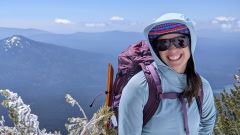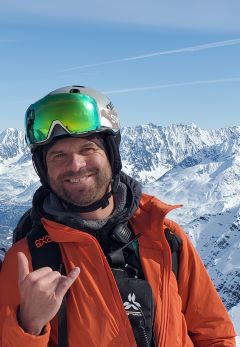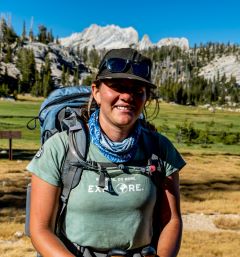CSAW Speaker Spotlight on Guest Presenters
The 22nd annual Colorado Snow and Avalanche Workshop (CSAW) is Friday, October 27 at the Riverwalk Center in Breckenridge. CSAW is an annual speaker series with content aimed at avalanche industry workers, advanced recreationalists, and anyone else interested in snow and avalanche science. All are welcome to join for a day of presentations, networking, and displays from our industry partners. This year, we are delighted to host several professionals and researchers from all over to present on a variety of snow and avalanche topics that will both fascinate and offer practical take-aways. Below, you will find a sneak peek of their presentations. We will feature the remaining speakers in the coming weeks! You can register and see the full speaker schedule here.
Nata de Leeuw: “When is it a Wind Slab, and When is it a Storm Slab?” and “Meteorological Controls on Wind Slab Physical Properties”

Nata de Leeuw, a current snow science graduate student at Montana State University and former ski patroller in Canada, will present two research-based topics that are focused on everyday challenges for practitioners: how weather conditions impact the development of wind slab hardness and the discrepancy between forecasting storm and wind slabs problems in the avalanche industry. Her mixed background of ski patrolling and research shows in this practical research and offers practitioners valuable insight that can be applied in their work.
First, CSAW attendees will hear about Nata’s research to better understand and quantify how variations in meteorological variables (e.g., air temperature, dew point temperature, and wind speed) affect differences in wind slab hardness. Nata analyzed several weather parameters in Montana's Madison Range to understand what conditions cause harder wind-drifted slabs to develop—and potentially larger avalanches—compared to softer drifted slabs and smaller avalanches. These research findings could help improve avalanche forecasting and mitigation planning in windy climates like many mountain ranges in Colorado.
In Nata's second presentation, she looks at how operations determine the difference between wind and storm slab avalanches–despite each being explicitly defined by the Conceptual Model of Avalanche Hazard (CMAH) and how that leads to inconsistencies in these forecasts. She will share her findings and hopes this research will help promote discussion amongst avalanche professionals regarding the discrepancy as well as inspire ideas to improve industry consistency.
Doug McCabe: “Historic Wet Slab Avalanche in Post Season at Yellowstone Club”

Doug McCabe has spent 30 winters in the snow between his time ski patrolling in New Zealand and at the Yellowstone Club in Montana, where he currently serves as the Director of Ski Patrol and Snow Safety. In Doug's presentation, he will share his analysis of the significant inbounds wet slab avalanche that occurred in May of 2020, the weather and snowpack events leading up to this event, and the lessons learned for his operation.
This event involved six known, mapped avalanche paths and was the largest observed avalanche at the Yellowstone Club. This event occurred after the ski area had ceased operations due to the COVID-19 pandemic. An unusual combination of events—a significant cold, wet spring weather pattern followed by sustained, rapid warming without overnight freezing—essentially mimicked a rain-on-snow event on a delayed timeline. Thankfully, despite the size of this event, no one was caught, and damage to infrastructure was minimal. Wet slab avalanches of this magnitude are poorly understood and difficult to predict. However, they pose a significant threat to human life and property. Doug hopes the analysis of this event will help further the avalanche community’s understanding of wet slab avalanches and can improve wet slab forecasting.
David Richards:“Ski Resort RACS: Planning and development of a ski resort RACS installation from A to Z” and “What’s the Score: Scoring snowpits for better communication and decision making”

David Richards is the Director of the Alta Ski Area Avalanche Program and has worked at Alta for 22 years. During his time at Alta, Dave has helped develop a RACS program within Little Cottonwood Canyon as well as new explosives for avalanche mitigation generally. In one of Dave's presentations, he will take us through the progression of the RACS program and talk about pros and cons of different systems.
In Dave's second presentation, we will learn about communicating snowpit data and assessments, which is critically important for avalanche professionals who are managing and mitigating avalanche danger. Communicating snowpit data and assessments is complicated, especially when sharing results with large numbers of people to both professional peers and the public and through different channels. Dave will share a snowpit scoring system that he developed in order to facilitate more efficient communication of snowpit assessments.
Lindsey Rotche: “Human-Centered Avalanche Susceptibility Mapping (H-CASM): A new perspective on avalanche susceptibility maps”

Lindsey Rotche is a Ph.D. student at the University of New Mexico whose research focuses on Geographic Information Systems (GIS), natural hazards, snow science, and climate change. Outside of academia, she ski patrols and knows firsthand that with backcountry winter travel increasing in popularity, the importance of accessible avalanche safety information is crucial.
Lindsey's presentation looks at backcountry avalanche mapping from the perspective of avalanche risk to people traveling through avalanche terrain. Instead of using maps with discrete bins for slope angle shading, she shows a new way to look at mapping with continuous gradient shading that incorporates not just start zones but the runout of avalanche paths as well. This new methodology is called Human-Centered Avalanche Susceptibility Mapping (H-CASM).
